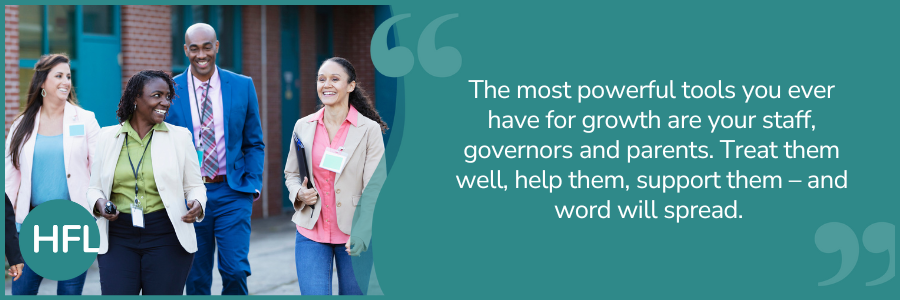
In 2019 I started as the new CEO of a Church school trust. It was one of the most fulfilling, rewarding, demanding and pivotal roles of my life. When I left the trust to take a new role as CEO of HFL Education in 2023, the MAT had grown from seven schools to thirteen, and we had elevated those that joined the trust as ‘inadequate’, despite initially have histories of in-year deficits – and managing a pandemic along the way. It was genuinely a joy to be part of the trust, and I still feel the pains of not being with my ‘family’ when I see them thriving and growing under new leadership.
As I look back, we went through a lot as a team. There are things we were (and are) enormously proud of, and of course, things I would have done differently. There always are. But in hindsight, what were the key lessons I learned from the journey?
1. Know why you are and who you are
Our trust was a Church school trust, so for them (and for me) values and vision came first. What did we believe about life and learning? That is the most important thing to keep returning to, in good times and bad. You have to know what is different about your trust and what is the same, and why. One minor example was branding and communication – you can be dazzled by other trust’s posters and social media, and end up thinking you need to write more, do more all the time. Reach were clear that they are the cornerstone of schools in their trusts, and that local branding comes first. Other trusts like Harris are more unified with umbrella newsletters and websites. Some local trusts have their CEO visibly out and about in the community every day, with daily photos on social media and in local news. You can’t be all things to all people – so knowing if you are all about empowering local schools and providing the quiet ‘wind beneath their wings’ or whether you are trying to build a ‘Specsavers’ type brand for schools to drop into is key. What kind of trust are you, and how does that inform how you communicate, brand, teach, lead, write job descriptions? Spending time with school leaders to work this out together is so helpful – you need to be united on this before you can do anything. If your staff are expecting to be a branch manager, you need to say if that is not what you do, to both manage expectations, but also make sure you are all pulling in the same direction. All trusts are so different, and finding your own trust’s place in the world is key.
2. Have high standards, but not at the expense of your staff
It goes without saying that standards and outcomes for pupils are priorities for all trusts. We all, as professionals, know that academic outcomes are one of the most important indicators of long-term health, wealth and happiness. So, the need to drive up standards and improve practice is something all trusts focus on – even outstanding schools need to be ever reflective and improving. However, it is also important to keep in your mind, as you push on standards, that your staff are your greatest asset. Treat them well, with respect, with support in times of crisis and celebration in times of joy. I am really proud that the turnaround in our schools’ fortunes did not come because we burnt things to the ground and started again. I genuinely believe that school staff want to do well and make a difference, they need the leadership, framework, support and training to help them – just like children do. We are all just big children. So, a people strategy, including a clear understanding of how you will enable staff to be individuals that can flourish in a larger community, is key. It is tempting when you have a deficit to remove CPD budgets, but this is something that needs managing with care. Get it wrong and you have your school winging down the standards tables and getting tricky OFSTED outcomes; your pupil numbers go through the floor, and you are in a worse deficit than before. Some of the schools joined us as inadequate had endured this cycle – so ensuring that people were invested in and kept in touch with the wider educational agenda was something we knew we had to preserve (even if through cost efficient methods…)
3. Get governance right; make it a priority
I think I learnt this one the hard way! Governance is so important in all trusts. When I started at the trust, we had regional governing boards and a trust board. It sounded sensible on paper, but the regional governors were exhausted, could not know their local schools well enough, and were not located in the community. It took me too long to do this, but we moved back to a trust board and local advisory board model in the end. Local presence is both local insight and local marketing. It is both local challenge and local support. And our governors could be tough on us in the trust, but they were driven, passionate and engaged people. And they were worth their weight in gold. I would always rather deal with an adult that is hard for me to manage than an easily led, agreeing one who doesn’t care. So, as soon as we could, we hired a governance officer who put the advice, training and support in that they needed and deserved – and this is one key role that you need someone brilliant in. Luckily, we had someone who was able to drive local governance and build us a supportive army to drive up standards. Trust Board members are vital too – they can be asked a lot and need to be given the tools and support to do their roles. My Chairs were challenging, strong – and their fortnightly catch ups were key and immovable times in my diary. So, a governance officer and local governance is, to my mind, a necessity not a luxury.
4. Have growth in mind all the time, but don’t seek growth at all costs
Growth is always talked about at MAT events, and I have had many peer-led conversations about how to grow. Whilst it is important to know what your growth strategy is, achieving this is never about a sales strategy or sales activities. Having a growth strategy based on your vision (phase? area? rationale? benefit?) is key, but the main thing is not to sell in order to grow. Maintained schools are terrified that trusts will be somehow be trying to gobble them up, and so are always on the defensive because of rumours and stories they hear circulated. The most powerful tools you ever have for growth are your staff, governors and parents (who are also staff and governors). Treat them well, help them, support them – and word will spread. Sometimes you need to remind staff to say the things they say to you to their friends, but it is a bit like OFSTED. Things are not quite right if you get out of bed to do well in an OFSTED. A good report should be the by-product of serving your community well. Growth is a by-product of being a strong, supportive community. Being honest about what you can and can’t do, and who you are and who you aren’t is actually far more attractive to schools than a glossy brochure and promising that ‘life will go on as before’. It won’t, it can’t – things do change. But I found that honesty is attractive, and although we walked away from some schools, and schools walked away from us, many schools were appreciative of and engaged by our clarity and as a result, we found the schools that were happy with our way of working.
5. Protect your trust; do due diligence wisely
Linked to the above point is the need to be really, really careful about your trust as schools ask to join. Every school added to a trust is a responsibility, and equally is the responsibility for all schools in your trust. Knowing that, and making sure that your family can remain strong and stable is worth far more than the income from another school. That means that due diligence is very important – for you and for the prospective joinee. You have to know where you and they will have to adapt to make it work, and genuinely know if this is a step too far for either of you at that time. The DfE process for joining a trust is not due diligence, it is the DfE’s legal process – you absolutely have to do your own careful research yourselves before entering the DfE process. I learnt that the hard way too, and the resultant new process made everything better for everyone.
6. Be outward facing
It is so, so important to get out and about. We say that to school leaders all the time, but as a trust CEO it is even more important. By ‘getting out’ I don’t mean just to visit people, but to have a structured focus visit – how do they manage their IT? How do other trusts manage their estates? Contrary to everything I read before I took up my role about how aggressive and competitive MAT CEOs are, I found that (almost) everyone I spoke to was honest, humble and willing to share. Networking events can feel self-indulgent, but I never regretted going out when I did, as I always came back with a new perspective or idea. I didn’t do this enough, and if I went back to a trust in another CEO role, I would make sure I spent planned, structured time to learn from others. It is not a luxury; it is core to trust improvement.
7. Know when to leave
I loved my job, but I do believe this is also important – I knew when it was time to go. As with all leaders, I had strengths and weaknesses. As with most recruitment processes, I think my strengths were what the trust was looking for at the time. But as time passes, you build your strengths into a system, and they become the trust strengths. Your blind spots equally get magnified over time as they mirror your leadership style. As a trust leader, your job is about children and learning, and I do believe we have a moral responsibility to do the best for them. There comes a time when you have to see that you have done all you can. Moving on so they can find another mix of other strengths and weaknesses which mirror their current profile is healthy.
My time as a CEO of a trust was an absolute honour and privilege, and I hope one day to return to a similar role. But for now, I have another job I love, working with MAT CEOs, and my wonderful trust has the perfect leader for their next stage in their journey. I wouldn’t want it any other way.
We are pleased to introduce our new termly newsletter, specifically crafted to meet the unique needs of Multi-Academy Trusts (MATs). Each MAT faces distinct challenges, such as navigating complex regulatory frameworks, managing diverse school environments, and striving for both compliance and educational excellence. Our newsletter aims to inform and educate, providing valuable insights, resources, and updates to support your trust in thriving.
What is inside?
Our newsletter includes a range of sections to offer thorough coverage of MAT-related topics:
- Latest news and updates: stay informed about the latest policies, regulatory changes, and educational trends affecting MATs.
- Case studies and success stories: learn from the experiences of other trusts. We will showcase case studies that highlight successful initiatives and strategies implemented by trusts across the country.
- Leadership and governance: different perspectives on effective leadership and governance practices.
- Professional development corner: we will feature the latest blogs and articles that provide valuable insights and tips for your CPD.
- Upcoming webinars and events: information about key events and webinars that provide different CPD and networking opportunities.
And if you would like to receive our newsletter directly to your inbox, please subscribe. Feel free to share the subscription form with someone who might be interested.



